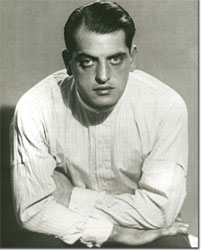Luis Buñuel: Essential film
Biography and Filmography
Luis Buñuel, filmmaker who has been regarded as a cultural reference of what was part of the twentieth century. Artist imperative for some to explain, in terms of film, which was surrealism.
The Surrealism was an artistic
movement emerged around the twenties of the past century and reached the
final days of World  War II, breaking even, in some cases, this period of
history.
War II, breaking even, in some cases, this period of
history.
Synthesizing the most, one can say that the latest claim of surrealism was
to express the actual functioning of thought.
This stream began as a movement of writers, but soon spread to other disciplines (painting, sculpture, film), given the immense potential offered. For example, in painting, invented the automatic painting and naturalistic figuration, with Dali, a friend and companion study of Bunuel, the greatest exponent. And in the film, the starting point of surrealism comes with "An Andalusian Dog" signed by Buñuel and Salvador Dalí same. While before performing "An Andalusian Dog", Buñuel had already pergeñado, in the same year (1928), his first film project, "The World For Ten Cents", with a dash of Ramon Gomez de la Serna.
Surrealism, Dalí as expressed at a conference in 1935, which was trying to challenge that the creation was an exclusive monopoly of those considered geniuses. "Poetry should be made by the entire world, not just by a few."
This initial work carried out by two men who end up being regarded as geniuses, the work was transferred to the subconscious language film and was also the basis of argument Buñuel's first film, as far as the exaltation of eroticism and the denial of any order established. "Un Chien Andalou" got an unexpected success of the public. In the words of Xavier Villaurrutia was "a number of loaded images of an unusual cruelty, within a dense atmosphere of anguish."
Buñuel tried to study engineering in Madrid, but failed to enter the faculty. He completed a degree in Philosophy and Letters in 1924. Its passage through the Residencia de Estudiantes, where he met Dali, Garcia Lorca, Alberti and a long list of men who made up what was called the Generation of 27 - was decisive. The residence was a place where culture, in all its forms of expression, ran naturally, attached to the Free Educational Institution, was a center that went like Albert Einstein or the Nobel Prize for literature Bertrand Russell to give talks and lectures.
The first controversy: In 1930 Buñuel wheel "The Golden Age," whose premiere
is surrounded by the scandal: French fascists "Action Française" almost
destroyed the room where the film was exhibited. Was removed from courtroom
for his anticlerical clear while the surrealists wrote one of his famous
manifest in his defense.
Buñuel in Mexico: Mexico has been portrayed by Juan Rulfo and Gabriel García
Márquez as a place of magic realism, for André Breton or Artaud was the
place par excellence of surrealism (the latter in its preceded Buñuel establishment at the end of the decade the thirties). Although Buñuel
calling at the country, in 1946, as a political exile, after passing through
the United States, where he worked at the MOMA New York and Hollywood for
the Metro GOLDWING Meyer, and how they faltered after presenting his film
career, unable to remain in Spain after the fall of the Republic, War and
the Franco dictatorship.
In Mexico, Buñuel lived for 37 years, until we reached the death and
nationality since 1949. And he lived there as a personal choice, as he put
it, and not "just because of circumstances," something very different from
other artists, who sought the paradise found otherwise. It is the era in
which Neruda, the poet, writer and diplomat Guatemalan Luis Cardoza y Aragón
or the Peruvian César Moro stop in Mexico, regarded as the artistic and
cultural center of the world wars while destroying everything in its path,
creating only exiles.